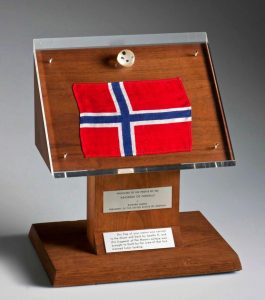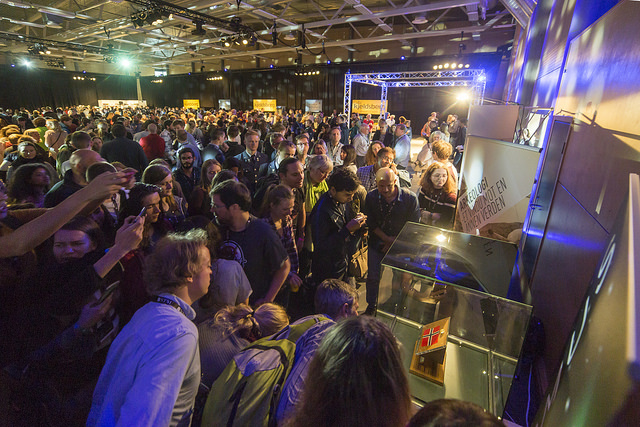
The displays were presented as gifts to 135 countries as well as US states and territories. Each lunar sample was sealed and mounted together with the flag of the recipient country, which had also been to the moon and back. Similar gifts were also created after the Apollo 17 mission to the moon. Norway received two of these displays – one from Apollo 11 and one from Apollo 17. Of the 370 lunar samples donated by the USA, 184 have now disappeared.
Moon rock at the NTNU University Museum
The moon rock sample from Apollo 11 that was donated to Norway has been among the “missing” presentation displays. It has not disappeared, but is in the geological collection at the NTNU University Museum (article in Norwegian). It is not on display at the moment, but is in safe keeping in the museum’s storage facilities. The other moon rock sample, from the Apollo 17 mission, has been displayed .
More about the donation
The package with the lunar sample display was addressed to the director of the museum, but was received by the then administrative manager Hans Jørgen Lønne. The plaque remained in Lønne’s office for several years before it was transferred to a vault. On a few brief occasions, the plaque has also been on display.
The gifts from the Apollo 11 mission were given to the countries of the world by Richard Nixon. The plaque at the NTNU Museum of Natural History and Archaeology bears the following inscription:
“Presented to the People of Norway by Richard Nixon, President of the United States of America.
This Flag of Your Nation was carried to the Moon and Back by Apollo 11 and This Fragment of the Moon’s Surface was brought to Earth by the Crew of That First Manned Lunar Landing.”
The missing moon rocks

The quest for the missing moon rocks began as early as 1998, when the lawyer Joseph Gutheinz, who was then employed at NASA, published an advertisement – “Moon Rocks Wanted” – in USA Today. One of the results was an offer to buy a moon rock sample that had been given to Honduras from the Apollo 17 mission for USD 5 million. The rock fragments weighed 1.142 grams. Other examples of the value of lunar material is a private collector’s purchase of 0.2 grams of moon dust from the Soviet Luna 16 mission for USD 442,500 in 1993. Attempts to sell moon rocks presented to Spain and Cyprus have also been documented.
Some moon rocks have disappeared because of revolutions, theft and fire. They include two rock samples given to Gaddafi’s government in Libya and one given to Romania’s former dictator Nicolae Ceaușescu, which disappeared after revolutions in these countries. Malta’s rock from Apollo 17 was stolen and Ireland’s rock from Apollo 11 disappeared after a fire in an observatory in Dublin.
Since 1998, Gutheinz and his students at the University of Phoenix and Alvin Community College in Texas have tracked down 77 rocks in total.
Gemini has written about the hunt for our moon rock (article in Norwegian).
Moon rocks

Moon rocks are pebbles, dust, rocks and other samples collected on the moon by the American Apollo and the Soviet Luna missions. The rocks from the moon are very old compared with rock found on Earth. The age of the moon rocks varies from 3.2 to 4.6 billion years. In comparison, most rock in Norway is 0.5 billion years old or more. The oldest rock is from the Lofoten Islands, aged about 3 billion years. The oldest rocks found on Earth are between 3.8 and 4.2 billion years old.
The composition of the moon rocks is very similar to rock from Earth. The differences are that the moon rocks contain much less iron, they lack volatile chemicals such as potassium, and they lack water altogether.
Another difference between the moon and Earth is that the moon is geologically dead, with solid rock down to a depth of about 1000 km and no demonstrable volcanic activity during the last 3 billion years. In contrast, Earth is geologically active, with a thin crust of solid rock down to about 40 km on average and active volcano activity.

